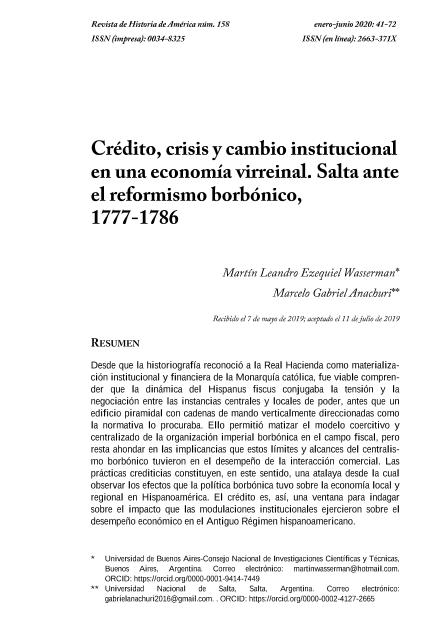Artículo
La Guerra de los Siete Años (1754-1763) demostró a la Corona española la urgencia de fortalecer la defensa en territorios estratégicos. La tensión entre España y Portugal condujo al gobierno borbónico a robustecer los recursos para la defensa de sus dominios en el Río de la Plata y a implementar reconfiguraciones institucionales concordantes. En ese proceso, una multitud de deudas con actores locales y regionales permitió a la Hacienda Real en Buenos Aires sostener el aparato defensivo. Si actores comerciales locales encontraban en dicho financiamiento un campo lucrativo, incrementar recursos fiscales con fines militares era un punto de confluencia entre los objetivos de la Corona, la reconfiguración institucional y los intereses de acreedores locales. Así, la mediación de actores locales en el funcionamiento del Erario pervivía durante el proceso de centralización institucional borbónica. Since historiography recognized the Royal Treasury as an institutional and financial materialization of the Catholic Monarchy, it was feasible to understand that the dynamics of Hispanus fiscus combined tension and negotiation between central and local instances of power, rather than a pyramidal structure verticallu commanded. This allowed to discuss the coercive and centralized model of the Bourbon imperial organization in the fiscal field, but it remains to delve into the implications that these limits of the Bourbon centralism had on the performance of commercial interaction. Credit practices constitute, in this sense, a window to observe the effects that Bourbon politics had on the local and regional economy in Spanish America. The research on credit is, thus, way to investigate the impact that the institutional modulations exerted on the economic performance in the Old Spanish-American Regime.The main objective of this article consists in investigate the impact that the Bourbon reforms could have on the commercial economy in Hispanic America, through a statistical and relational reading of the notarized credit in Salta, one of the most important commercial nodes of the Viceroyalty of Río de la Plata.In this sense, the present work concludes that the institutional change implied in the establishment of the Intendancy of Salta del Tucumán (1784), even when could not achieve the fiscally subsumption of the Salta region to the rioplatense epicenter —as it was projected by a centralization fiscal policy—, encouraged the commercial integration between Salta and other regional markets as a way to overcome the crisis derived from breakdowns in interregional trade generated by the Andean uprisings of the 1780s.For more than two decades, Hispanic American historiography managed to explain that notarized credit served, during the seventeenth and eighteenth centuries, to articulate long-distance commercial circuits and linking mercantile nodes. Ratifying the hypothesis of that historiography, this article delves into those questions through an annual reconstruction of credit movements during the decade that runs between 1777 and 1786, appealing to methodological tools from both statistics and social network analysis, previously underutilized. This will make it possible to understand the impact of institutional change on an Old Regime economy, focusing on the relational dimension of credit and the commercial structure to which it maintained and to which it expressed. The sources used for this approach consist of the deeds of obligation signed by the scribe of Salta during the period.
Crédito, crisis y cambio institucional en una economía virreinal: Salta ante el reformismo borbónico, 1777-1786
Título:
Credit, crisis and institutional change in a viceregal economySal: ta and the Bourbon reformism, 1777-1786
Fecha de publicación:
05/2020
Editorial:
Comisión de Historia del Instituto Panamericano de Geografía e Historia; Organización de Estados Americanos
Revista:
Revista de Historia de América
ISSN:
0034-8325
e-ISSN:
2663-371X
Idioma:
Español
Tipo de recurso:
Artículo publicado
Clasificación temática:
Resumen
Archivos asociados
Licencia
Identificadores
Colecciones
Articulos(INSTITUTO "DR. E.RAVIGNANI")
Articulos de INST. DE HISTORIA ARGENTINA Y AMERICANA "DR. EMILIO RAVIGNANI"
Articulos de INST. DE HISTORIA ARGENTINA Y AMERICANA "DR. EMILIO RAVIGNANI"
Citación
Wasserman, Martín Leandro Ezequiel; Anachuri, Marcelo Gabriel; Crédito, crisis y cambio institucional en una economía virreinal: Salta ante el reformismo borbónico, 1777-1786; Comisión de Historia del Instituto Panamericano de Geografía e Historia; Organización de Estados Americanos; Revista de Historia de América; 158; 5-2020; 41-72
Compartir
Altmétricas




